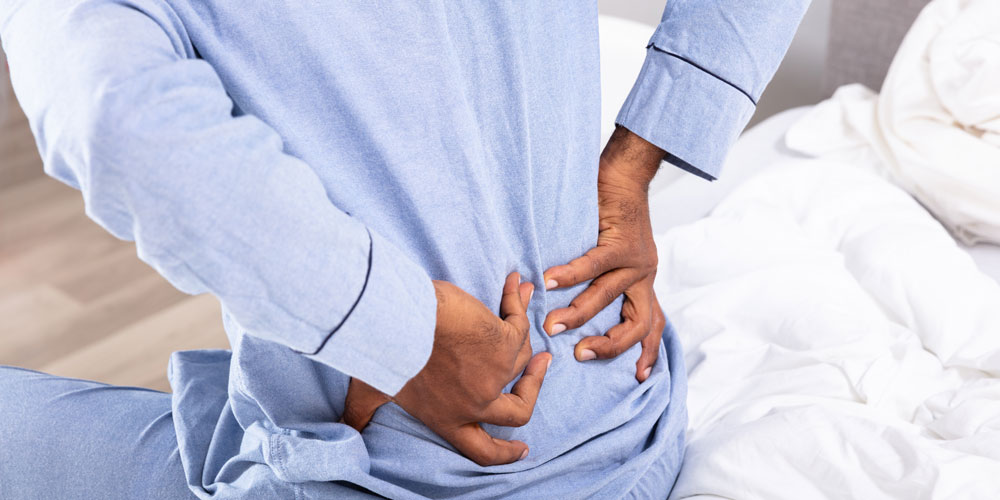
17 Jun Living with Lower Back Pain? Common Causes, Prevention and Treatments
Eighty percent of adults will experience significant lower back pain sometime during their lifetime. Lower back pain usually involves a muscle spasm of the supportive muscles along the spine. It may cause, numbness, and tingling in the buttocks or legs. There can be multiple reasons for back pain and prevention is extremely important. Dr. Zaib walks us through the causes of lower back pain, treatment options and prevention methods.
Back pain is a common concern amongst adults and may have many underlying reasons. Some common causes of low back pain are:
- Muscle strain: Muscles of the lower back provide strength and mobility for activities of daily living. Strains occur when a muscle is overworked or weak.
- Ligament sprain: Ligaments connect the spinal vertebrae and provide stability for the lower back. These ligaments often become injured with a sudden, forceful movement or prolonged stress.
- Poor posture: Poor postural alignment such as slouching or sitting hunched over a desk can create muscular fatigue, joint compression, and stress on the discs that cushion your vertebrae. Years of abuse can also cause muscular imbalances such as tightness and weakness leading to pain.
- Age: “Wear and tear” and inherited factors may cause degenerative changes in the discs and joint facets of the spine. Normal aging causes decreased bone density, strength and elasticity of muscles and ligaments. These effects can be minimized by regular exercise, proper lifting and moving techniques, proper nutrition and body composition.
- Disc bulge, or herniation, can cause pressure on a nerve, which can radiate pain down the leg, also known as This generally responds well to strengthening and stretching exercises (physiotherapy) and rarely requires surgery.
- Other causes: Back Pain can be initiated by bladder/kidney infection, endometriosis, cancer, or ovarian problems.
If you are suffering with back pain, most treatment options consist of:
- REST: Rest from any form of heavy activity that can aggravate the back muscles. Avoid prolonged sitting, driving, bending, heavy lifting or twisting.
- ICE: Ice applied to the lower back for 15 minutes every 1-2 hours is helpful in reducing pain and spasm. Avoid using heat for the first 48 hours of an acute injury.
- MEDICATION: Your doctor may prescribe anti-inflammatory medication such as aspirin, advil, ibuprofen or naproxen sodium.
- EARLY EXERCISE: Gentle exercise for mobility and stretching can help decrease the severity, duration, and recurrence of low back pain. Do not perform exercises that increase your pain.
- POSITIONING: Modifying your sleeping position can help ease strain to your lower back. Make sure your bed is firm enough to give you adequate support, and use a small pillow for your head. If you sleep on your back, try putting a pillow under your knees. This can help relieve the stress on your back muscles. If you sleep on your side, put a pillow between your thighs. If you are side bent, a folded towel under your waistline helps. Avoid sleeping on your stomach.
The best way to prevent lower back pain or further injury:
- Once the severity of pain has decreased, a rehabilitation program to strengthen your hip, abdominal and back muscles (core) can help prevent recurrences. Your doctor can refer you to a specialist for this type of program.
- Remember good posture! If you work at a desk job, remember to get up and walk around regularly. The goal is to maintain a neutral spine, beware of a slumped or over-arched spine.
- If you are following an exercise regimen, tell the trainer or coaches and ensure you are using the proper lifting techniques. Avoid lifting heavy weights and ensure you stretch before and after any exercise routine.
Lower back pain can usually be resolved with adequate rest, however see your health care provider immediately if you have the following: significant pain that persists beyond a week, unexplained fever, unexplained weight loss, redness or swelling on the back or spine, pain /numbness /tingling that travels down the leg below the knee, leg weakness, bowel or bladder problems, or back pain due to a severe blow or fall.
If you have any questions or concerns about your health, or if you are suffering with back pain, ask your Health at Hand doctor for advice through our app that can be easily downloaded from the App Store. Click here for more information.



